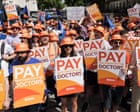Amid apparent rising pay, economists are concerned about the consequences of a possible shift in the balance of power
When Eastbourne’s refuse collectors secured a huge 11% pay rise, increasing to 19% for the lowest paid, it seemed like worker power was back.
It was early 2022 and inflation was rocketing on its way to a peak of 11%. In a desperate scramble to keep pace with rising prices to protect their incomes, workers across the UK’s public and private sectors took widescale industrial action in a way that brought back memories of the 1970s. What followed was a series of pay deals thrashed out between bosses and employees, with unions often arguing they had been due pay increases for years.
Amid apparent rising pay, economists are concerned about the consequences of a possible shift in the balance of powerWhen Eastbourne’s refuse collectors secured a huge 11% pay rise, increasing to 19% for the lowest paid, it seemed like worker power was back.It was early 2022 and inflation was rocketing on its way to a peak of 11%. In a desperate scramble to keep pace with rising prices to protect their incomes, workers across the UK’s public and private sectors took widescale industrial action in a way that brought back memories of the 1970s. What followed was a series of pay deals thrashed out between bosses and employees, with unions often arguing they had been due pay increases for years. Continue reading… Economics, Bank of England, Industrial action, Pay, Trade unions, UK news, Industrial policy, Inflation, Working from home, Office for National Statistics, Interest rates Business | The Guardian























































































































